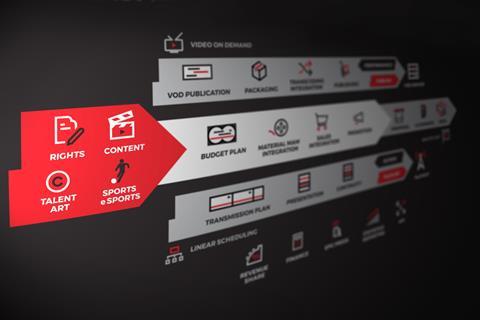With a dramatic reduction in the amount of live content including sports, broadcasters and other content creators are seeking to monetise ‘back-catalogue’ material more effectively, writes David Davies.

In normal times discussions about rights management tend to be dominated by premium live content – sports especially. But these are anything but normal times, with the pandemic meaning that there is currently significantly less live sports than would usually be the case. As a result, broadcasters and content creators have been obliged to think more carefully about the reuse of archive material and the ways in which it can be freshly monetised.
Michelle Munson is CEO and founder of Eluvio, whose Content Fabric platform aims to transform the management, distribution and economics of premium video for content owners. She agrees that bringing archive content to the fore is “certainly the major theme among our customers at the moment. In general the number one priority is to be able to have the content library online and ensure that customers can have high quality online viewing experiences. Then they wish to combine those capabilities with licensing and selling.”
But there also signs that the freeing up of time pressures around premium live content is giving broadcasters the opportunity to think more seriously about long-term rights management. In particular, there appears to be plenty of interest around solutions that will enable greater automation, through Artificial Intelligence (AI) and Machine Learning (ML), for tasks including the tracking of content rights and the identification of the most profitable life-cycle for individual pieces of content.
- Read more: Interview - Michelle Munson, Eluvio
‘Who, when, where’
There are several primary reasons that the Content Fabric provides a good solution for back catalogue licensing and monetisation, indicates Munson: “First of all, those selling the rights know that in our case all the rights are reinforced throughout the blockchain access controls. It is also possible to [determine what] full authorisation should entail, as well as access controls at the title and asset level.” As a result customers can be “entirely clear on who is using which titles over which period”.

Munson says that the current surge in interest around archive content encompasses linear TV as well as VOD and OTT. She reveals that Eluvio is “involved in a few projects with large broadcasters around originating live linear channels [using such content] in the fabric, and devising authorisation polices to go with this.”
With potentially huge amounts of content to make viewing decisions about, broadcasters require solutions that will help them allocate material to different tiers quickly and seamlessly. “Once you get past the first tier content that the broadcaster knows is very popular, it’s primarily a matter of agility,” says Munson. “In this regard, [Content Fabric] can help by enabling the user to make their own highlights and self-curated lists. These can be added to the blockchain wallet of each user and also made visible to the curation teams, so they can feedback to those making decisions about [content usage].”
Like many industry observers at the moment, Munson anticipates further changes to licensing and distribution of new movie content that would hitherto have made its debut via theatrical release. Pandemic-related cinema closures have meant “a real explosion of interest here, including in pre-release private online screenings with digital ticketing.” While studios have been releasing new movies to the major portals, Munson thinks there will also be more individual platforms from studios and producers that will allow them to take a greater cut of the profits: “Up until recently there hasn’t been much opportunity for direct monetisation from content owners and creators. But we think direct exhibition is very much possible now, and that there will be greater moves towards that.”
‘Overall lifecycle of rights’
MEDIAGENIX is a mainstay of rights management solutions, with its customers including M&E conglomerates and groups (eg. Nordic Entertainment Group), telcos, media networks (eg. A+E Networks UK), and national public service and commercial broadcasters, including BBC in the UK, TG4 in Ireland, Talpa TV in The Netherlands, and VRT and DPG Media in Belgium. Its current offer includes the WHATS’ON management software that optimises linear and VOD scheduling, content workflows and channel management, and the RIGHTS OUT web app for generating additional revenue from content and rights.

One of the company’s current priorities is to improve the connectedness between rights and broadcast management, allowing data – for example, from rights contracts – to always be at the core of operations. Nikias Arts, product manager at MEDIAGENIX, explains: “Ideally, rights management systems would scan all contracts and automatically create a portfolio of available rights. But within rights management systems this is difficult to achieve, due to the many ways rights can be described and the different formats of the contracts, where we often see that large studios impose their own formats. However, these original contracts hold a treasure of information, which is important for strategic purposes. For example, setting up a windowing strategy for your rights is [highly dependent] on where and when the original right you acquired is available.”
For these reasons MEDIAGENIX has been working on ways “to facilitate the entry of contracts into WHATS’ON which will to some extent still require a human brain for verification purposes and so on. Once entered into the system, however, the data stays at the centre of the operations – from acquisition to consumption and sales – and is continuously updated so that all departments (eg. sales and scheduling) work in sync with the same real-time data. This makes it possible to visualise the overall lifecycle of rights [and define] the strategic distribution.”
Looking ahead, Arts anticipates automation technologies playing an increased role in determining the path taken by an item of content: “In the longer-term, and assisted by AI and ML, it should be possible for a rights management system to suggest the most cost-efficient or profitable lifecycle for a piece of content. As to underlying rights, copyrights and revenue share, we think new technologies will eventually make it possible to track every single frame of a piece of digital content so that you will know where and when it has been used, by who, who the beneficiaries are, and what amounts should be paid to them. This is also why we are putting so much emphasis on including these parts within our overall rights solutions.”
Cause for consolidation?
The increasing complexity of rights management means that there is likely to be consolidation among businesses catering to different aspects of the process. We have already started to see this happen with deals such as National Bank’s acquisition of rights management specialist FilmTrack in August 2019. The acquisition, said the bank, was intended to “strengthen City National’s leadership in providing the entertainment industry with complex payments and intellectual property rights management,” and followed on from the previous purchases of accounting software firm Datafaction and payment SaaS provider Exactuals.
AI and ML are also destined to play an increasing role in the delivery of a more optimised and seamless rights management environment. Where premium live content might have previously tended to dominate the discussion, current events have highlighted the importance of optimising archive material, and as such these two prime content areas could well be viewed on a more equal plane in the future.
























No comments yet